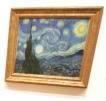 The Starry Night has really turbulent swirls.© AP Photo/Mary Altaffer
The Starry Night has really turbulent swirls.© AP Photo/Mary AltafferVincent van Gogh is known for his chaotic paintings and similarly tumultuous state of mind. Now a mathematical analysis of his works reveals that the stormy patterns in many of his paintings are uncannily like real turbulence, as seen in swirling water or the air from a jet engine.
Physicist Jose Luis Aragon of the National Autonomous University of Mexico in Queretaro and his co-workers have found that the Dutch artist's works have a pattern of light and dark that closely follows the deep mathematical structure of turbulent flow1.
The swirling skies of The Starry Night, painted in 1889, Road with Cypress and Star (1890) and Wheat Field with Crows (1890) — one of the van Gogh's last pictures before he shot himself at the age of 37 — all contain the characteristic statistical imprint of turbulence, say the researchers.
These works were created when van Gogh was mentally unstable: the artist is known to have experienced psychotic episodes in which he had hallucinations, minor fits and lapses of consciousness, perhaps indicating epilepsy.
"We think that van Gogh had a unique ability to depict turbulence in periods of prolonged psychotic agitation," says Aragon.
In contrast, the Self-portrait with Pipe and Bandaged Ear (1888) shows no such signs of turbulence. Van Gogh said that he painted this image in a state of "absolute calm", having been prescribed the drug potassium bromide following his famous self-mutilation.
Measured chaos
Scientists have struggled for centuries to describe turbulent flow — some are said to have considered the problem harder than quantum mechanics. It is still unsolved, but one of the foundations of the modern theory of turbulence was laid by the Soviet scientist Andrei Kolmogorov in the 1940s.
He predicted a particular mathematical relationship between the fluctuations in a flow's speed and the rate at which it dissipates energy as friction. Kolmogorov's work led to equations describing the probability of finding a particular velocity difference between any two points in the fluid. These relationships are called Kolmogorov scaling.
Aragón and colleagues looked at van Gogh's paintings to see whether they bear the fingerprint of turbulence that Kolmogorov identified. "'Turbulent' is the main adjective used to describe van Gogh's work," says Aragn. "We tried to quantify this."
Darkness and light
The researchers took digital images of the paintings and calculated the probability that two pixels a certain distance apart would have the same brightness, or luminance. "The eye is more sensitive to luminance changes than to colour changes," they say, "and most of the information in a scene is contained in its luminance."
Several of van Gogh's works show Kolmogorov scaling in their luminance probability distributions. To the eye, this pattern can be seen as eddies of different sizes, including both large swirls and tiny eddies created by the brushwork.
ADVERTISEMENT
Van Gogh seems to be the only painter able to render turbulence with such mathematical precision. "We have examined other apparently turbulent paintings of several artists and find no evidence of Kolmogorov scaling," says Aragon.
Edvard Munch's The Scream, for example, looks to be superficially full of van Gogh-like swirls, and was painted by a similarly tumultuous artist, but the luminance probability distribution doesn't fit Kolmogorov's theory.
The distinctive styles of other artists can be described by mathematical formulae. Jackson Pollock's drip paintings, for example, bear distinct fractal patterns.
Visit our goghpaintedperfectturbu.html">newsblog to read and post comments about this story.
National Autonomous University of Mexico
-
References
- Aragón I., et al. Preprint http://www.arxiv.org/abs/physics/0606246 (2006).
